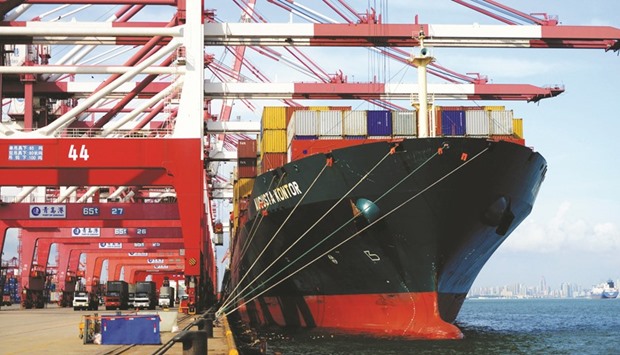China’s economy, the world’s second largest, struggled in July with a worse-than-expected trade performance as imports plunged 12.5% year-on-year, Customs said yesterday.
Imports fell to $132.4bn, data showed, as weaker global commodity prices and lacklustre domestic demand weighed on purchases.
The drop in imports was significantly larger than expectations for a 7% fall, the median forecast in a survey of economists by Bloomberg News.
Exports also fell in US dollar terms, dropping 4.4% to $184.7bn – compared with expectations of a 3.5% decline.
As the world’s biggest trader in goods, China is crucial to the global economy and its performance affects partners from Australia to Zambia, which have been battered by its slowing growth – while it faces headwinds itself in key developed markets.
July was the fourth month in a row that exports declined in dollar terms, and analysts described the figures as disappointing.
“Signs of stronger manufacturing activity among many of China’s key trading partners has so far failed to lift export growth,” China economist for Capital Economics, Julian Evans-Pritchard, said in a research note.
“At the same time, the renewed fall in global commodity prices is dragging down import growth,” he said.
China’s imports have been shrinking since late 2014 with global raw material costs hammered as the country’s once blistering expansion lost steam, hurt by manufacturing overcapacity, a slowing property market and mounting debt.
July saw imports fall by the most since February, when they lost 13.8%.
“China’s trade data was unimpressive in July,” ANZ Banking Group said in a research note, which added the outlook for the second half of the year was “challenging”.
“Over H2 2016, sluggish growth in Europe and Japan is likely to drag on China’s exports.
Brexit will further weigh on exports to the EU,” it said, referring to Britain’s vote to leave the European Union.
In the first seven months of the year, total trade volume with the EU – China’s biggest trading partner – rose 1.8%, Customs said in a statement.
Trade with Japan was up just 0.8%, but it fell 4.8% with the United States, data showed.
China is embroiled in rows over steel exports – it produces around half the world’s output of the metal – with the EU and US accusing it of dumping.
It exported 10.3mn tonnes of steel in July, Customs said, up 5.86% year-on-year but down 5.85% in June.
But stock investors ignored the weak trade performance, with the benchmark Shanghai Composite index closing up nearly 1% yesterday.
July’s fall in exports came despite weakness in China’s yuan currency – also known as the renminbi (RMB) – which has helped overseas sales by making Chinese goods cheaper.
“Yuan depreciation has helped China’s exports to some degree,” Citic Bank International chief economist Liao Qun told AFP.
Chinese officials deny the government is deliberately allowing the yuan to slide to boost exports, arguing economic fundamentals are responsible.
China’s foreign exchange reserves, already the world’s largest, stood at $3.2tn in July, down by just $4.1bn from June, official figures showed on Sunday.
The world’s number two economy grew 6.7% in the second quarter of this year, the same as the first quarter, slowing from all of last year.
The economy expanded 6.9% in 2015 – its weakest in a quarter of a century – and the government has targeted growth in a range of 6.5%-7% for this year.
Analysts said China will need to further ease monetary policy, such as cutting the amount of funds banks must hold in reserve, to keep growth on track.
“Trade data, especially weak import growth, are further evidence of slowing domestic momentum in July,” Nomura’s chief China economist Zhao Yang said in a research note.
“We maintain our view of a growth slowdown and accommodative policy bias, given weak domestic demand and still-low albeit stabilising external demand.”

Cargo containers wait to be transported on a ship at a port in Qingdao, Shandong province. China’s economy, the world’s second largest, struggled in July with a worse-than-expected trade performance as imports plunged 12.5% year-on-year, Customs said yesterday.
